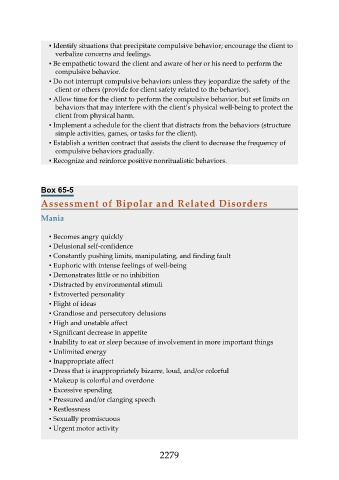Page 2279 - Saunders Comprehensive Review For NCLEX-RN
P. 2279
▪ Identify situations that precipitate compulsive behavior; encourage the client to
verbalize concerns and feelings.
▪ Be empathetic toward the client and aware of her or his need to perform the
compulsive behavior.
▪ Do not interrupt compulsive behaviors unless they jeopardize the safety of the
client or others (provide for client safety related to the behavior).
▪ Allow time for the client to perform the compulsive behavior, but set limits on
behaviors that may interfere with the client’s physical well-being to protect the
client from physical harm.
▪ Implement a schedule for the client that distracts from the behaviors (structure
simple activities, games, or tasks for the client).
▪ Establish a written contract that assists the client to decrease the frequency of
compulsive behaviors gradually.
▪ Recognize and reinforce positive nonritualistic behaviors.
Box 65-5
Assessment of Bipolar and Related Disorders
Mania
▪ Becomes angry quickly
▪ Delusional self-confidence
▪ Constantly pushing limits, manipulating, and finding fault
▪ Euphoric with intense feelings of well-being
▪ Demonstrates little or no inhibition
▪ Distracted by environmental stimuli
▪ Extroverted personality
▪ Flight of ideas
▪ Grandiose and persecutory delusions
▪ High and unstable affect
▪ Significant decrease in appetite
▪ Inability to eat or sleep because of involvement in more important things
▪ Unlimited energy
▪ Inappropriate affect
▪ Dress that is inappropriately bizarre, loud, and/or colorful
▪ Makeup is colorful and overdone
▪ Excessive spending
▪ Pressured and/or clanging speech
▪ Restlessness
▪ Sexually promiscuous
▪ Urgent motor activity
2279

